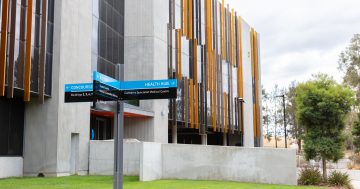
The Australian National University has the lowest proportion of low-income students in the country. Photo: Michelle Kroll.
New data from the Department of Education reveals Canberra’s two biggest universities have some of the country’s lowest numbers of low-income students.
Student representatives claim the figures reflect rising costs and inadequate support at ACT universities, but the institutions themselves blame a statistical anomaly.
Since 2010, the federal government has invested $1.5 billion into increasing the number of students with low socioeconomic status (SES) in universities.
However, the proportion of domestic undergraduates from low-income backgrounds has back-slid in recent years, with increased barriers preventing talented Australians from attaining life-altering qualifications and skills.
With just 3.5 per cent of its undergrads coming from low SES areas, the Australian National University (ANU) has the lowest proportion of disadvantaged students in the country.
As for the University of Canberra (UC), it tied with Bond University (private) for the third lowest proportion at 6.2 per cent.
This places both ANU and UC well below the national average of 16.22 per cent, which has declined by 0.83 per cent since 2017.
The data defines low-SES students students as those who reside in low-income postcodes.
These figures come amid the federal government’s ambitious new target to increase that number to 20 per cent by 2035.
That would require 35 per cent of new domestic enrolments to be made up of low-SES students over the next 10 years.
When asked how Canberra’s two largest universities can play their part in meeting the target, Education Minister Jason Clare told Region, “[they] are autonomous institutions and questions about which students are enrolled and why are best put to them”.
“At the moment, almost one-in-two Australians in their late 20s have a university degree. But not everywhere. Not in the regions. Not in poor families,” he adds.
“This has to change. If we don’t, we won’t have the skills and the economic firepower we need to make Australia everything it can be in the years ahead.”
Asked why they ranked so low, spokespeople for both universities said the department’s postcode-based metrics fail to identify the socioeconomic status of Canberra residents accurately.
“This method is problematic for ACT universities because it is ACT Government policy and practice to distribute social and affordable housing options across all Canberra suburbs,” says UC Deputy Vice-Chancellor Professor Michelle Lincoln.
Phoenix O’Neil is the president of the ANU Students Association (ANUSA). They blame “prohibitively high rent for the majority of residential halls and a lack of financial support from ANU” for the universities’ rankings.
“I think the fact the ANU has a higher percentage of on-campus interstate and international students than other Australian universities shows that it’s not just because we’re based in Canberra.”
A spokesperson from ANU says the university is committed to reflecting the diversity of our nation.
“Any student who has the desire and the marks to study at ANU is welcome at our university. [It] has a range of initiatives in place to enrol and support students from low SES backgrounds, including 18 equity scholarships with a value of more than $1.2 million.”
The universities with the largest proportion of low SES students were all regionally based, with CQ University (43%), the University of Southern Queensland (34%), and the University of New England (30.3%) leading the way.




















